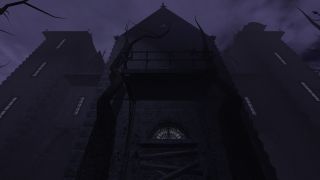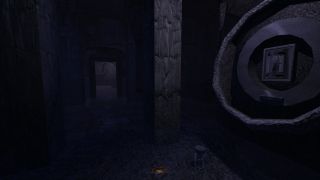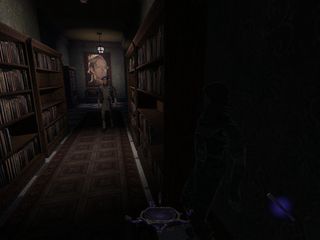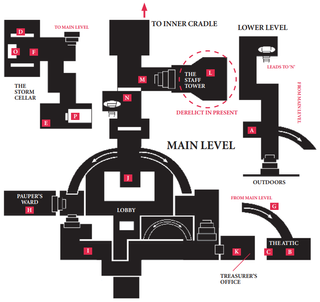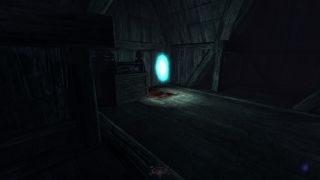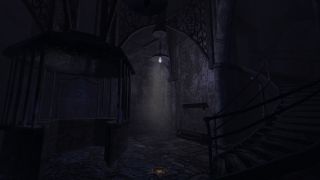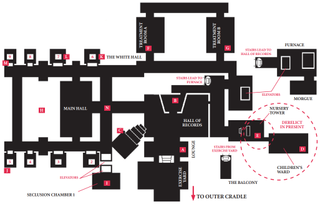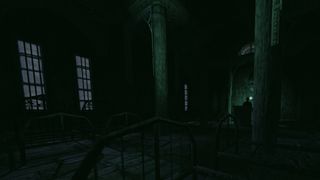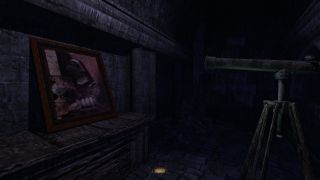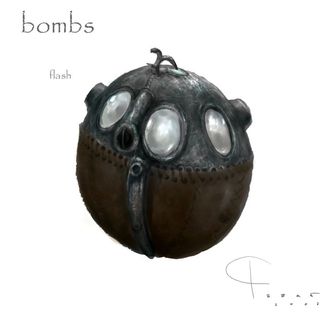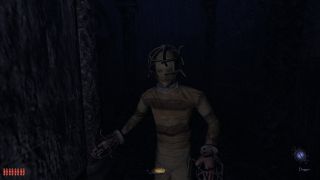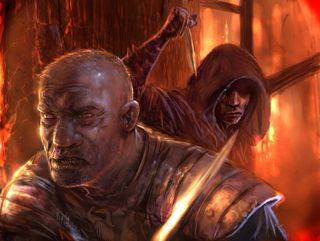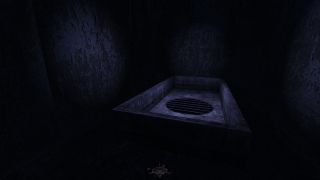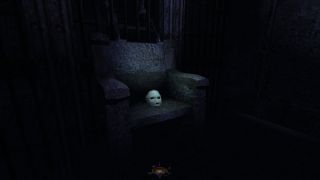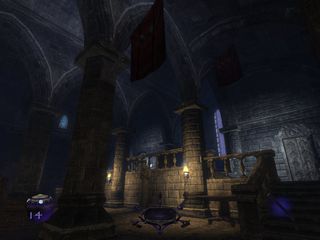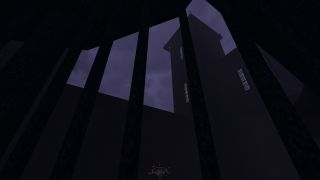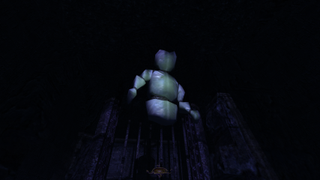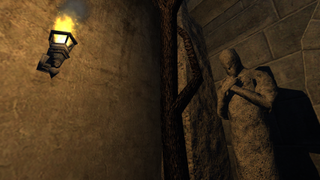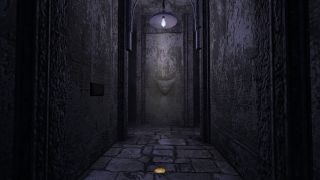We’re digging into the PC Gamer journal archives to publish items from years passed by. This text was initially printed in PC Gamer problem 146, March 2005.
WARNING: READ ME FIRST
The next kinds a journey into one of the vital good and disturbing ranges ever dedicated to PC. In the event you’ve performed The Cradle—Thief: Lethal Shadows’ centrepiece degree— then do not hold again. The secrets and techniques and hidden tales of this home of hell are explored, analysed and constructed into one thing that can hopefully improve and illuminate the expertise you’ve got had. In the event you’ve by no means performed The Cradle, and haven’t any plans to ever accomplish that, then rush proper in, and extra idiot you. In the event you’ve by no means performed The Cradle, however plan to… watch out. This opening accommodates spoilers. The mapped part ought to be considered in the identical method as a walkthrough for a recreation you have not performed. The interview with Jordan ‘Null’ Thomas, The Cradle’s designer, ought to be protected. You’ve gotten been warned.
It is too late to run. Working from The Cradle is like working from the air round you. Folks bandy the phrase “immersive” round when discussing videogames, however miss the subtext of what they’re actually speaking about. To be immersed is to be surrounded and submerged, thrust into a brand new context. If The Cradle is about something, it is immersion. Your head pushed beneath murky waters till you choke and drown.
The Cradle is the penultimate degree in Thief: Lethal Shadows. It is what’s recognized in tv parlance as a “format breaker”—one thing that subverts most of the set expectations of the present to stir the essential palette into new life. Whereas The Cradle relies on Thief’s shadow-stalking mandate, and a transparent extrapolation from the primary Thief’s seminal Return to the Haunted Cathedral, it has amplified its supply materials to grow to be one thing fairly totally different. It is in all probability the scariest degree ever made, an experiment in non-linear storytelling strategies that pays off handsomely and a towering achievement for video games.
Like anybody who performs The Cradle, I used to be anxious earlier than I even arrived. Maybe greater than most; in a passing e-mail, Thief’s venture lead, Randy Smith, had talked about a “haunted home” degree which was a deliberate extrapolation from the theories he specified by a Concern characteristic in Gamer’s prehistory. I used to be anticipating one thing particular, so waited till the witching hour and performed the sport on a wall projector in entrance of a bunch of unnerved friends. Even in Garrett’s introductory speech (opens in new tab), he would not sound his ordinary cocksure self. For the primary time, he sounds anxious. The extent begins and… there it’s.
The Shalebridge Cradle. An ornate gothic façade on a dilapidated mansion. The beginning view is angled so that you are looking up and it is looming over you want a livid father or mother about to self-discipline a baby. On this first second, The Cradle’s themes are set—the connection between these with energy and people with out, authority and the oppressed.
Sound-man Eric Brosius? He’d have been burned as a witch.
The extent’s genius is that it by no means explicitly states its objective. The reality is barely approached tangentially, within the non-linear methodology of storytelling completely distinctive to video games. That’s, by way of immersion. The extent would not inform you a narrative. It offers you clues, and also you inform the story to your self. It is this strategy of realisation that gives a few of the most annoying moments in The Cradle. You are informed from the beginning that it was a madhouse. You are informed that earlier than that it was an orphanage. It is solely if you’re inside, studying a baby’s scribbled observe, that you just realise The Cradle served each functions on the similar time.
It is a horrific concept. A number of years in the past, one in every of my associates was sectioned, believing he was both the Anti-Christ, the Son of God or Muad’Dib from the Dune books. The cliché’s true: it’s important to giggle, or else you cry. However after I visited him, in halls that stunk of disinfectant, full of people that solely checked out you thru drugged eyes, laughter was unattainable. Insanity is probably the most scary factor on the earth, and an asylum its church. The concept of the criminally insane intermixed with the stray youngsters of a metropolis is a horrendous idea, pure melodrama. If it was simply informed to you, you may need rejected it as merely that. However because the concept was hinted, and also you made the dreadful leap of logic your self, you settle for.
Now, I’ve performed The Cradle a half-dozen occasions making ready this characteristic, and whereas the preliminary journey continues to be the one which squats at the back of my thoughts evident, it is by no means a cushty place to be. A few of its torture-blades boring when the shock is spent and you recognize what’s taking place, others stay completely whetted. They’re the incisions which assault your guts by way of temper and timbre: that’s, what the place seems like and what it appears like. That sound and pictures can disturb has lengthy been recognized: the Roman Catholic Church expressly forbade the creation of church music that includes chords together with a diminished fifth (“The Satan’s interval”) as a consequence of its profound impact upon the psyche.
Sound-man Eric Brosius? He’d have been burned as a witch. His Thief and System Shock 2 credit make as superb a resumé for horror as anybody within the enterprise, however The Cradle is absolute career-best work. Principally a drunken miasma of sound is smeared throughout your audio system, making you uneasy till an surprising noise splits asunder. Distant sounds stand up, suggesting the scuttling of unknown issues shifting elsewhere, as much as no good. Moments of plot-revelation are supplied a chilling counterpoint by an apposite ghostly sound impact—discover the ashes of a child, nonetheless in a crib, and anticipate to be haunted by its cry from past the grave. The flickering of lights would not be the identical with out the tiny crackle. And, most memorably, as you inch up in direction of the attic, the sounds of room-shaking violence that both petrify you or ship you working again the way in which you got here.
On the visible facet, issues are simply as intentionally mistaken. In any case—there are visible methods as disturbing because the Satan’s Interval to use. Take the Cradle’s inhabitants—the puppets, whose actions are fastidiously judged to look unnatural. They do not transfer like folks. They transfer as if their insides are about to separate or their bones have been damaged and set at off-angles. The artwork right here is to not be mistaken (as in not right) however Incorrect (as in so near being regular… however not fairly). Irrespective of how lengthy you keep, there’s at all times one other element to shake you if you’re getting too cozy, like realising the lights within the constructing pulse, as in the event that they have been slowly respiration, or… Nicely, when mapping a piece for this characteristic, I bodily screamed when one of many inmates pulled himself from the bottom unexpectedly and lurched to assault.
And these touches unnerve on each journey into The Cradle. The primary time you stroll down the steps into its basement, when you recognize nothing, it is devastating. The masterstroke is that the primary half of the extent is empty. Nothing’s there, so that you spend nearly the primary half of the go to inching round darkened corridors, attempting to work out what went mistaken whereas leaping at shadows. You hate the darkness, as you recognize it may very well be concealing something. After which, as soon as you’ve got reactivated the turbines, full with the kind of rattling mechanical scream that you just simply know may have alerted something with one thing vaguely analogous to ears inside a sq. mile, the electrical lights twitch again into life and also you’d do something to have a superb darkened alcove to crouch in once more. Masterful psychology: make you hate one factor, then take it away in a method which makes you would like for its speedy return.
It is this way of thoughts recreation that kinds the muse on which the entire Cradle is constructed. Insecurity is reinstated by altering the foundations simply as you’ve got grown aware of them. As you discover the Outer Cradle, it’s only your individual worry that twists the knife. By the point you realise you are being manipulated, you’ve got entered the Interior Cradle. Right here the corkscrewing of your guts has been externalised within the type of the inmates’ impossibly convulsing our bodies. Whenever you grasp that specific drawback, the Cradle twists once more and transports you from its present ruined state into its reminiscences of earlier occasions, to be chased by way of a pallid, fish-eye world by the black silhouettes of long-dead workers—actually faceless authority figures.
The Cradle would not have a historical past. It has a scream, stretched out by way of time.
Ah. The Cradle’s reminiscences. It is by this level you’ve got realised that Shalebridge is not fabricated from bricks and mortar, however one thing extra. The years of brutality and institutionalised torture sublimed into some shapeless intelligence that desires nothing higher than to maintain you right here endlessly. Whilst you merely view the place as a constructing at first, by the point you allow it is clearly an adversary—its character expressed on the earth you’ve got fearfully sneaked your method by way of. It by no means speaks on to you. There’s not one of the apparent taunting of an entity like SHODAN in System Shock 2, however when your each motion is thwarted it is painfully apparent that one thing needs to maintain you, in the way in which a abdomen retains a snack.
There are moments the place you suppose, in opposition to all logic, it may truly do this. The Cradle is the longest degree within the recreation. Earlier than the shut, I had an eye-of-the-storm second after I puzzled if there was in reality any method out of this place, or whether or not the true finish of Thief 3 is to be batted round like a mouse within the diseased paws of some malevolent feline, endlessly.
However, sure, finally you do escape. Besides that isn’t actually true. Sure, the extent ends. You do escape The Cradle. However, since you’ve been there, it lives on in your thoughts in soiled little fragments of reminiscence… and so it escapes in you.
The Cradle’s in me. In the event you’ve performed it, it is in you. Even when you have not, by studying this, a shadow of my dread is forged in your thoughts. So we’re all carrying it with us, like a darkish little secret or black twitching egg, ready to hatch and let its brood stretch your pores and skin to breaking level and fall twitching into the sunshine.
It is too late to run. However do not let that cease you. Run.
Abandon all hope
Whereas most movies particularly feed you the story on a drip, the most effective video games put you in a context which you discover. The Cradle is filled with clues—in its sounds, in textual content, in graphics, within the motion of its inhabitants—which you piece collectively inside your head then carry out an act of closure upon to fill-in the gaps. You are not informed the story; a world exists, and also you remodel it right into a coherent picture by way of the facility of your thoughts. In different phrases, precisely the way in which you collect various data from the true world. Any recreation can do that. Many have. The Cradle does it significantly nicely, so makes a superb instance for us to look at extra intently.
On the next annotated maps are marked the extra important clues you discover when enjoying The Cradle, together with some notes on their attainable significance. After that’s an try to rework them right into a linear narrative. In the event you’ve performed The Cradle, take it as a information to the place. If you have not… basically this can be a videogame homicide thriller, remodeled to paper. We present the clues and supply what we expect is a possible and entertaining answer.
Beforehand: earlier than coming into the Cradle you recognize little concerning the place. You come as a result of Hammerite Inspector Drept noticed the Grey Girl right here when he was a baby, as she killed his pal Lauryl. It is your solely attainable hyperlink to catching up with this mysterious determine and uncovering what horrors she plans for the Metropolis.
The Outer Cradle
A) Notice: “It was higher earlier than. Too many guidelines to recollect. Do not go right here. Do not contact that. Do not discuss to the sufferers. The Medical doctors are simply as scary because the sufferers. Miss Arthur says orphans should not complain.” The second you realise Shalebridge was an orphanage and asylum concurrently.
B) Lauryl’s portrait: The second you contact this, you grow to be conscious of Lauryl’s ghost and capable of talk along with her. When you free Lauryl, she disappears from the body—The Cradle now not has any maintain on her. Related query: who painted it?
C) Lauryl’s ghost: Nonetheless haunts the placement of her homicide within the attic, blood stains nonetheless seen. Regardless of its ovoid form, this bubble of sunshine casts a human shadow. It is a incredible impact as a consequence of its impossibility being extra tangible than it will be in one other medium, comparable to movie. Look intently and you’ll see the tender define of Lauryl’s face on its floor. She acts because the voice-in-your-head plot information for a lot of the recreation. Focal point for followers of System Shock 2—the identical voice actress, Thief author Terri Brosius, additionally performed SHODAN, who fulfilled an identical, if extra aggressive function.
D) Lauryl’s blood: In a vial. Nonetheless heat. Yuk.
E) Case examine: Examines one C Pins, the affected person in room 7. Claims he is adorned his cell like “The Homicide Scene”. Discusses his obsession with birds. Foreshadowing of in-mate viciousness and disturbing obsessions.
F) Case examine: This one’s of F Topper, in room 6, who was discovered carrying an urn stuffed with ashes which she claims is her little one. She treats it precisely like a child. Beneficial experimental Hanscomb’s remedy. Foreshadowing of the brutality of the regime. Take heed to the sound impact of a child crying after you learn this, for a primary instance of sound used to strengthen the impression of your discovery.
G) The staircase: Rattling noise as you head up the steps, supplies one of many largest scares. One thing’s occurring up there. Finest guess: the ghostly echoes of the homicide.
H) The pauper’s ward: Low safety ward. Notice its location—it is not behind the heavy safety gates. A observe describes somebody amassing gold enamel from the morgue for revenue, maybe implying employees right here too.
I) Notice: “I did not wish to have my image painted, however I used to be too scared to say no. I suppose I did it proper as a result of he mentioned I sat good and nonetheless.” A observe, in all probability written by Lauryl, since hers is the one unmutilated portrait within the constructing.
J) The foyer: Other than wanting stunning, noteworthy for a e book that offers a really feel for the establishment’s coverage on lobotomy: “extra may be realized from a surgical procedure carried out incorrectly, so we’ll hold the coaching to a minimal.” Good. Additionally claims that this may occasionally resolve the issue of an “rebellion” at The Cradle.
Okay) Treasurer’s workplace: Helpful to a thief for the cash it accommodates, however plot related because of the notes on Dr Hanscomb’s experimental warmth remedy to dry the “extreme humours” that are, he believes, a reason for insanity. “The warmth should be of the dry selection” he urges, and “sizzling components should be laid instantly onto the pores and skin.”
L) The workers tower: Lauryl warns you that nobody is allowed to go up there. Within the “actual” time interval, it is destroyed and in rubble, making exploration unattainable. Whenever you first enterprise into the previous, it exists once more. When explored once more after utilizing the Cage to move your self into the previous—that’s, to a later interval than the primary—the complete place is emitting ghostly smoke, as if on fireplace.
M) The chair: Solely current when visiting the latter of the 2 time intervals, it faces the Employees Tower, casting a dramatic shadow. Suggests that somebody was watching it throughout this era.
N) The doorways: Heavy metallic doorways, solely able to being operated from the skin. Implies that the damaging stuff is past this level.
O) The cage: The place they saved new prisoners coming into The Cradle. Lauryl urges you to not go in, for worry of The Cradle noticing you. Ultimately you are pressured into doing so, with a purpose to enter the previous in your escape—which brings you to a wholly totally different interval to earlier journeys. Apparently, it’s also possible to use the cage earlier than you’ve got been informed you’ll be able to.
P) The generator: All lights are off and entry to the Interior Cradle barred till you substitute its fuse. This suggests that the doorways to the Interior Cradle have been shut for a substantial size of time, and also you’re probably its first customer.
The Interior Cradle
A) The lounge: Accommodates a very blackened hearth. Fascinating, that.
B) The corridor of information: The centre of the Interior Cradle, most necessary for its itemizing of the sufferers, their therapies and their privileges. Particularly related is the affected person in room 9, who was allowed to mild the hearth within the lounge if she continued to behave. For this objective, she was allowed to maintain her tinderbox.
C) The observatory: Right here you may discover an inmate, presumably the one from Cell 5. The room is filled with portraits, every defaced with a bloody smear over the face. Jewels are positioned the place their eyes ought to be. The inmate, till disturbed, perpetually strikes between them, ensuring every is positioned appropriately. This suggests perfectionism was a essential trait.
D) The nursery tower: Within the current day, burnt down and inaccessible. When you journey into the previous, you’ll be able to find Lauryl’s diary in the primary ward. Info additionally involves mild on the Grey Girl: the report on Lauryl’s dying which claims that one of many sufferers will need to have killed the woman, as a result of this Grey Girl concept is clearly ludicrous. “The workers blamed him for what occurred to me,” Lauryl reveals after you’ve got learn it. “They have been mistaken.” Who’s “him”? There’s additionally a observe to the impact that guidelines to maintain sufferers and orphans separate should be adopted.
E) Ghostly workers: The Cradle solely animates the workers when you’re up to now, and even then, solely as spectral reminiscences in silhouette. Since The Cradle is kind of able to animating the precise corpses of the sufferers, it’s important to ask the place the our bodies of the workers went to stop it from doing this to them. That that is how The Cradle “remembers” folks additionally tells you one thing about its perspective on the world.
F) Remedy room A: Dwelling of the asylum’s electrical shock and wet-heat therapy room. “I noticed a person all wrapped up in moist bandages,” Lauryl informs you as you enter, “I believe he needed me to assist him, however I used to be too afraid.” Tells us that orphans and sufferers combined to a point. Additionally observe a wax masks resting on the electrical chair: somebody discarded it right here.
G) Remedy room B: The lobotomy theatre, containing Dr Ranker’s specifically made silver instruments. Features a observe congratulating Ranker on his report on the “botched” lobotomy, speculating that “sooner or later they’re going to name the process the Ranker Lobotomy and apply it to probably the most tough circumstances.”
H) The white corridor: 9 cells, in a round formation round a central meal corridor. Every is adorned in line with the type of its occupant, solely probably the most notable of that are referenced right here. This complete part is closely locked down, with heavy metal gates stopping entry to the world outdoors. Lockpicking is required to get anyplace. Folks aside from Garrett would wish keys.
I) Seclusion chamber: Dwelling of King No One—a play on phrases of “#1” or “No. One”, his affected person quantity. Includes an elevator, ascending to an remoted cell. You hear the King’s manic giggle on the way in which up. Solely on the prime do you realise it is as a result of there is no button for sending the elevator again down.
J) Cell 5: A telescope is positioned, watching a portrait with the face reduce out. Clear hyperlinks to what you discover within the observatory. The cell has a false again wall the place, as soon as dismantled, you discover Lauryl’s blood-stained costume. If it is the Grey Girl who killed Lauryl, this affected person will need to have come into possession of it shortly afterwards.
Okay) Cell 6: Foreshadowed within the Outer Cradle, belonging to F Topper. Tiny child garments hanging above a crib. As you inch nearer, it turns into apparent that it is an urn not a baby that rests there.
L) Cell 7: Dwelling of C Pins, the Birdman of Shalebridge, foreshadowed within the Outer Cradle. Accommodates what’s presumably his re-animated type, standing, perpetually admiring his array of birds, nailed into the brickwork. A row of skulls relaxation on the desk.
M) Cell 9: A comparatively naked cell. It takes a second to understand that it is as a result of the complete place is burnt out, particularly in direction of the far facet. A tinderbox lies close by. Somebody clearly likes lighting fires.
N) The inmates: Bodily puppets of The Cradle’s will, within the “actual” materials airplane. Whereas they are often taken down with a bodily blow, they are going to solely rise up once more. The one solution to completely disable them is thru flashbombs and holy water. Discover the unearthly, jerky motion cribbed from Jacob’s Ladder.
The Shalebridge Cradle: Folklore
An exegesis
The next is an try to rework the varied clues and components of The Cradle described within the earlier pages right into a linear narrative. It is not a definitive story of “What occurred on the Shalebridge Cradle”. As Alan Moore speculated in his graphic novel From Hell, when coping with homicide “an answer, any answer, is inane. Homicide is not like books… it holds which means, and form, however no answer.” This is not the one method you’ll be able to piece the whole lot collectively by any means, and far is extrapolated from the clues. However when positioned within the coronary heart of one thing as intentionally baroque as Shalebridge, there are some leaps which it’s important to make on intuition. That is mine. In the event you’ve thrown your self out of The Cradle’s highest window and located your self in a special place, I would have an interest to listen to about it
The Metropolis is used to strangeness. The weird is the mortar that holds it collectively. Its individuals are a hardy kind. In a world the place the useless will not keep buried, they need to be. It hardly counts as superstition when you recognize what’s on the market, at midnight, ready for an opportunity to make you be part of it. Nonetheless, even within the Metropolis, no-one loiters too lengthy within the shadow of 1 explicit constructing, which hangs off the east facet of the Outdated Quarter like some facial canker. Shalebridge Cradle. “If there is a solution to cram extra distress into one constructing’s historical past,” Grasp Thief Garrett as soon as mentioned, “I can’t consider it.”
The Cradle would not have historical past. It has a scream, stretched out by way of time.
It is mentioned Shalebridge was that unhappy institute for misplaced youngsters: an orphanage. It is also mentioned that it was that unhappy establishment for misplaced adults: an asylum. What most do not realise is that, throughout its latter days, it was each without delay. Whereas safer inmates have been saved within the pauper’s ward in direction of the entrance of the constructing, the murderously insane—of which, at The Cradle’s demise, there have been 9—have been saved within the White Corridor ward, in direction of the rear, with heavy metallic, lock-down doorways between them and civilisation. Close to them, the orphans, excessive within the Nursery tower. On the constructing’s coronary heart, wanting over all, was the Employees Tower, the stronghold of the lawmakers. Youngsters and the insane, underneath the lock and key of nurses and docs. Authority and oppression, certain collectively.
The story of Shalebridge rests on two youngsters—a boy and a woman. The boy, Drept, ran away, grew up, discovered redemption within the order of the Hammer and have become generally known as a fanatical hunter of shadows. The woman, Lauryl, did not get the prospect to develop up in any respect.
The top docs—Dr Sandbridge, Dr Ranker, and Dr Hanscomb—had strict guidelines which Matron Miss Arthur was to comply with. Apparent guidelines: comparable to homicidal sufferers and the youngsters weren’t to combine. However guidelines in a madhouse are likely to err, so it got here to move that Lauryl discovered herself sitting whereas having her portrait painted by the affected person in Room 5, generally known as The Watcher. He was delivered to Shalebridge after slaughtering his earlier sitters as a result of “they moved”. He then smeared his sufferer’s blood over every portrait’s face, in frustration on the lack of life within the ultimate work. Lauryl was a superb woman. Lauryl did not transfer in any respect. So, Lauryl lived and The Watcher made the one excellent image of his life.
Nobody is that fortunate twice.
The Grey Girl of fable and nightmare got here to Shalebridge to discover a physique to make use of for her devilish functions. Somebody discarded already. Somebody no-one would miss. That’s, an orphan. If Lauryl and Drept weren’t enjoying within the attic that day, perhaps the Grey Girl would have chosen a special sufferer. Would The Cradle’s cry have been stifled early? Maybe, maybe not. We are able to solely speculate as to the the reason why The Watcher was shut sufficient to the homicide scene to take Lauryl’s bloody, tattered costume as a memento earlier than anybody else arrived. Maybe the homicide he would finally carry the blame for would have occurred anyway? The Cradle’s delivery is rife with such sick irony.
Regardless of Drept’s testimony that some hag-like creature butchered his little pal, the fabric proof pointed on the man locked in cell 5. Excessive measures have been referred to as for: lobotomy. Or somewhat, all too widespread measures. The workers of Shalebridge—when not experimenting with their weirder theories comparable to making use of pink sizzling bars to reveal pores and skin or testing the outer limits of electrocution—turned to Dr Ranker’s customized silver knives that would transmute a pest right into a vegetable. The “outcome” may very well be saved cheaply with the opposite trash within the pauper’s ward somewhat than the costly White Corridor. Information unfold that no matter made The Watcher himself could be sliced away in Remedy Room 2.
These phrases finally reached the person who hid his shattered options behind a wax masks, Affected person #1—or “King No One” as he was recognized among the many inmates because of the script on his door. The truth that he was contained within the isolation chamber, on the prime of an elevator shaft within the White Corridor, wasn’t sufficient to separate him from the opposite sufferers. His toxic whispers leaked out, fanning the flames of dissatisfaction. The Watcher was a well-liked madman. His fraternity owed him an try to cease this. In any case, they may very well be subsequent. Dissent sparked right into a fiery riot. Earlier than something may very well be carried out, the keys have been with the sufferers. They have been all free. The gates have been sealed, however a lot of the youngsters and the workers have been inside, trapped and barricaded of their towers. A minimum of the fortunate ones have been—these on the bottom ground proved moist and scarlet sport for the rampaging White Corridor inmates.
The midwife to The Cradle’s true delivery was the affected person in cell 9, The Moth. A pyromaniac, she was allowed to maintain her tinderbox as a part of her remedy. Now free, she had all of the gas she may want for. She lit the matches which decreased Shalebridge to the skeleton of a constructing it’s now. First, in her room. Then, underneath the duvet of the riot and urged on by King No One, the fires on the base of the Employees tower.
Whereas the King discarded his wax masks, lastly revealing his molten face, and led the dismemberment of the remaining workers, The Moth pulled up her chair on the foot of the staircase and stared into the inferno as women and men have been decreased to soot and screams.
Flames swept up. The Nursery tower joined its sister in distress. The voices of girls and boys merged in an unholy choir, a shriek to empty skies. The smoke arose to the heavens, blacking them out, forming a cloud of the stays of authority. Something elevated was destroyed. All that remained was the bottom materials.
The tortured voices have been The Cradle’s birthing cry. The rising smoke was its first breath. Born of torture, oppression, authority, homicide and a historical past of weeping, the place was alive.
It pressed down upon the remaining inmates, who dominated the stays of the asylum underneath King No One’s malevolence. His Kingdom could not final, in earthly phrases. The doorways have been shut. There was no method out. The inmates sickened, withered and died.
It wasn’t the top.
The inmates rose from dying, turning into puppets of The Cradle’s will and twitching in meaningless echoes of their previous existence. The our bodies animated in a closed, spasming loop for 50 years, ready for another person to enter, to catch The Cradle’s consideration, and so be part of its everlasting, macabre dance.
They are saying its doorways will open earlier than you. They’re going to seal behind you. And so long as you are alive, it’s going to by no means allow you to depart.
Even within the Metropolis, no-one loiters too lengthy within the shadow of 1 explicit constructing, which hangs off the east facet of the Outdated Quarter like some facial canker. Shalebridge Cradle. “If there is a solution to cram extra distress into one constructing’s historical past,” Grasp Thief Garrett as soon as mentioned, “I am unable to consider it.”
Interview: Return to the Cradle
The Cradle designer Jordan Thomas speaks candidly concerning the making of worry.
JORDAN THOMAS
After a tenure as a journalist, the gamekeeper turned poacher when Psygnosis recruited him for the writing work on a variety of titles. Interning briefly at Surreal Software program, maker of dragon-and-semi-clad-lady recreation Drakan, Jordan’s first actual gig was engaged on—of all issues—Harry Potter and The Thinker’s Stone (PCG 105 78%) on the growth studio Amaze. Whereas there he learnt the intricacies of UnrealEd from Ben ‘cyberartist’ Golus, offering the ability foundation that landed him a job on Thief: Lethal Shadows. Initially a designer, he climbed the ranks to the mighty place of Lead Designer. Whereas his official duties saved most of his time, a major quantity of the after-hours was spent on establishing celebrated degree “The Cradle”, which you might have learn one thing about someplace. He cites Ben Golus as his level-building mentor and Thief venture lead Randy Smith as his game-design mentor. “Aside from that, I have been enjoying PC video games and considering critically about them since I used to be about 9,” grins Jordan, “And I am not carried out but.”
PCG The place did the vanity of The Cradle come from?
The Thief video games are—within the summary—largely about exploring unfamiliar, hostile areas. It appeared a sublime kind of conceit to take that idea actually, and easily feed Garrett (the final word trespasser) to an enormous constructing which harbours a kind of monstrous sentience, together with a perverse urge for food. We knew that our “haunted home” (the interior title) could be one of many latter entries within the story arc, and that it will pit the participant in opposition to the undead, in some type.
I had a collection of design discussions with Randy Smith (venture director on Lethal Shadows) about our intent for the area throughout its infancy. We shortly concluded that our core goal was to plan the one most terrifying first-person recreation expertise ever constructed. I am going to depart it as much as the fan base to resolve whether or not or not we achieved it. Concern is inherently subjective, in any case. On the very least, nobody can declare that we have been devoid of ambition!
PCG So what do you truly rely as terror?
By way of the aforementioned terror, we weren’t bent on eliciting fixed panic, per se. Our point-of-origin was the phrase “dread”. I prefer to outline it as that quintessential “threshold” sensation which whispers somewhat than shouts, warning you that you just’re seven steps from the unspeakable.
With that emotional form in thoughts, I started to draft the design equal of the extent’s “blueprints”. Suffice it to say, I took the method severely. It is in all probability apparent by now that the delicate manipulation of a participant’s darker feelings (most notably, worry) is an abiding curiosity of mine. Which is a flowery method of claiming that I am on a mad little campaign to enhance the standard and vary of video games within the horror style.
I need my scares to go away scars.
Jordan Thomas
PCG The place do you suppose horror in video games goes mistaken?
We have a deficit there, and it’s miles from unique to gaming; horror generally tends to ooze alongside the trail of least resistance. Assume again—in your whole life, what number of motion pictures have drawn you in deeply sufficient to make your guts go chilly in real fright? They in all probability quantity lower than 10, in the event you’re fairly hardy. With video games, I think you possibly can rely them on one hand.
Concern is thought to be one of many best feelings to stimulate with any audio-visual medium. It’s trivial to frighten a fairly receptive viewers. You want solely shout, “boo!” on the optimum second, and your victims will discover themselves clinging to the ceiling, quivering and hissing expletives.
Our reptile brains immediately reply, able to brandish the adrenals on the drop of a hat. However will the reminiscences final? Usually, no. They’re warning indicators, written in a really primary language. Because the thoughts rights itself, these messages fade away, leaving it largely unblemished.
I need my scares to go away scars.
PCG Nicely, there’s the pull-out quote. So how do you consider The Cradle?
Unsurprisingly then, I regarded The Cradle as a type of meta-project along with a recreation degree. It was to be a multi-layered experiment in interactive horror, utilizing gamers as hapless check topics. I suppose that is not completely with out irony, given the type of “science” fictionally practised inside its partitions.
The intent was to frighten, disturb, thrill, or startle as vast an viewers as attainable throughout the parameters I would been given. And, if attainable, to go away a number of of these “scars”. The jaded person would, hopefully, admire the grim narrative and bodily pressure. The extremely imaginative or impressionable gamers would discover themselves inching alongside by way of a simulated nightmare, attempting to not breathe.
And, in fact, I hoped to execute all of this with out sacrificing the important thing intrinsic strengths of Thief gameplay. Stealth is inherently conducive to a sense of vulnerability, however sometimes not fairly this pronounced. The Cradle was, all in all, a holistic effort in recreation horror and stealth degree design, meant to speak the sensation of dread in a number of complementary languages.
PCG What do you imply if you discuss holistic degree design?
The time period “holistic degree design” is not a buzzphrase a lot as a well-established artistic philosophy that’s typically put into follow throughout varied industries, however isn’t put into phrases. In plain phrases, it refers back to the analysis of any self-contained recreation section as an built-in complete. The whole package deal, because it have been. It typically manifests as a collection of questions, a few of which seem like these:
Are all of the mission’s systemic components gracefully woven into one another?Does the area really feel believably occupied by residing, imperfect beings?How nicely does it match into the experiential topography of the complete recreation?Does the top outcome provide the participant a seamless, unforgettable expertise?
I tried to successfully reply dozens of queries alongside these traces with The Cradle. In hindsight, I can see loads of room for enchancment, however that’s precisely how a developer expands the listing.
PCG So—what rewards do a extra holistic strategy give the developer?
The anticipated reward for this (somewhat fastidious) collection of trials may be summed up by one phrase: “resonance”. All of The Cradle’s actors, from the malfunctioning lights to the shambling undead themselves are tied right into a central choreographer object. It is a type of invisible “puppet grasp” that tells them easy methods to behave in the true world, and on the earth past (which is comprised of the asylum’s fragmented goals of its former days).
And, though The Cradle has its share of completely linear scripted sequences meant to induce the best temper, it’s the purely circumstantial moments that took probably the most planning. Every object household has a particular relationship to the remaining, which might manifest throughout gameplay once they occur to collide with one another. I am unable to predict precisely what sort of horrific moments shall be generated by that ecosystem, which is good.
PCG I will say the phrase “emergence” now. Thanks.
Life, which we broadly emulate—and sometimes, embellish upon—in video games, is the results of an unfathomable variety of programs interacting with one another in a type of everlasting dance. That is fairly simple to grasp, subconsciously or in any other case.
People are accustomed to the clear feeling of “rightness” that outcomes from being swaddled in such a stunning, orchestral synthesis always. The psychological recordings we make of all this information carry some inherent resonance, merely due to their unfiltered perfection. Simulations (like videogames) don’t practically make the grade but, and we regard them with inevitable scepticism. They merely can’t instantly compete for territory with reminiscences of the true world.
That mentioned, by specializing in a selected kind of goal expertise, and leaning closely on the human intuition to fill the gaps, we’re capable of cheat a bit… We invite gamers to persuade themselves {that a} sequence is “actual sufficient” or “tight sufficient” to be drawn into, by fastidiously integrating all the extent and recreation parts. Players have a discerning eye, however they wish to grow to be immersed.
PCG All fiction’s reliant on a leap of religion in that method, actually.
The extra acceptable the programs which might be already at work in a given degree, and the extra elegantly they seem to “plug into” one another, the simpler it’s for a human to grow to be a prepared participant within the suspension of their very own disbelief. Or, for that matter, within the suppression of their aesthetic scepticism. This supplies a type of oblique springboard into that notion of “rightness”.
As a result of, in that tiny microcosm of supported behaviour selections (say, stalking by way of an deserted constructing and attempting to not die), the community of simulated prospects is dense sufficient that you just stop poking holes within the world-fabric, and start actively filling them your self! Your creativeness turns into inextricably intertwined with the content material you are consuming, and also you grow to be a partial architect of your individual reactions.
The sport is then way more prone to resonate with you, carving out a everlasting area of interest amongst your long-term reminiscences. And that, in fact, is the honour for which we builders try.
PCG How a lot reference work did you make when making ready The Cradle?
The Cradle is the artificial offspring of dozens of precise, present Victorian hospitals and apparently haunted buildings. All of the distress, malpractice and dementia which were ascribed to these locations are seen right here by way of a proportionally exaggerated lens.
I learn reams of affected person and workers interviews, scoured numerous articles on historic mental-health therapy practises, compiled an enormous reference archive of images taken by city explorers who usually break into deserted asylums, and even visited a number of places myself.
PCG Any explicit incidents caught in your reminiscence out of your analysis?
One story concerned a affected person who managed to flee into the storage wings of the asylum, and due to her eroded state-of-mind, she grew to become misplaced and succumbed to hunger. The place was such a teeming “snake pit” that she wasn’t missed, and the stain from her physique seeped completely into the wooden.
One other concerned a person who was dedicated as a toddler. Many years later, when requested to signal his personal title, he drew a tough silhouette of the hospital. The place was so omnipresent and dominant a drive in his life that it eclipsed his identification. The Cradle was constructed out of that kind of cheery materials.
PCG And, lastly, what fictional influences formed The Cradle?
Among the many movies that helped encourage it have been Jacob’s Ladder, Session 9, and The Satan’s Spine. Books included From Hell, Home of Leaves, and The Shining.
My recreation influences are innumerable, however two most distinguished have been the Silent Hill collection and the System Shock collection, to which The Cradle owes an amazing deal.



